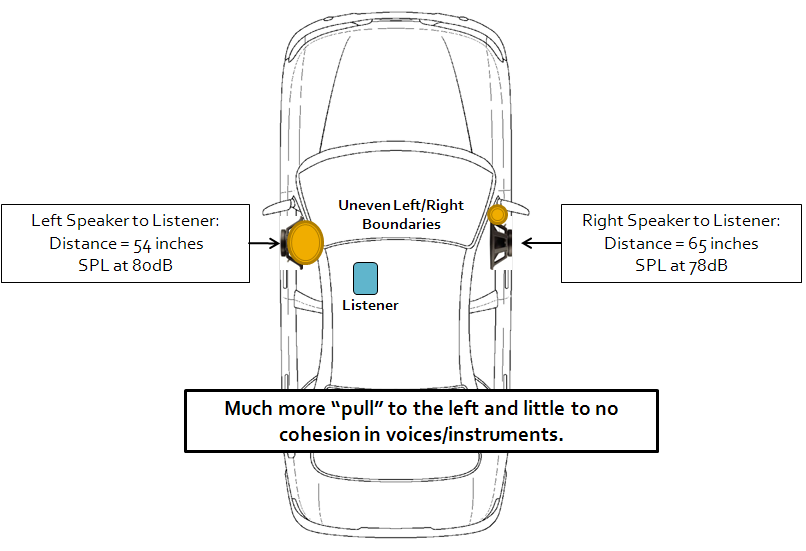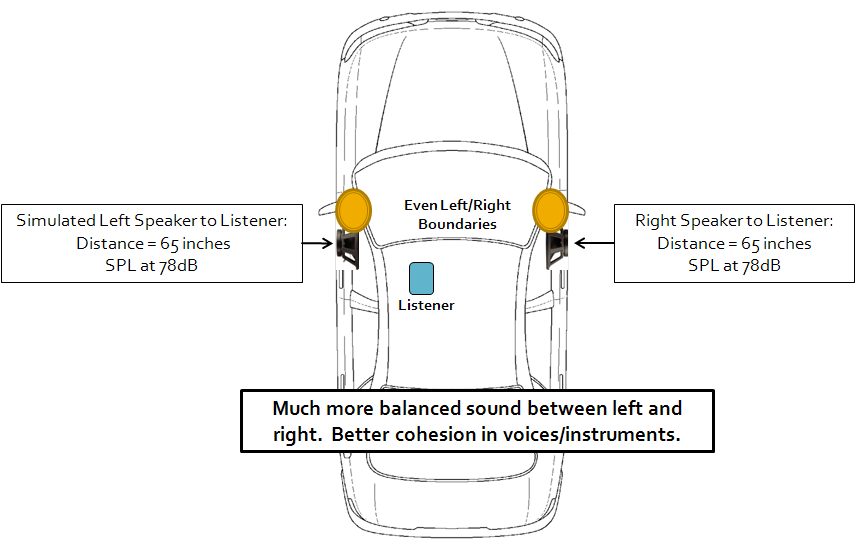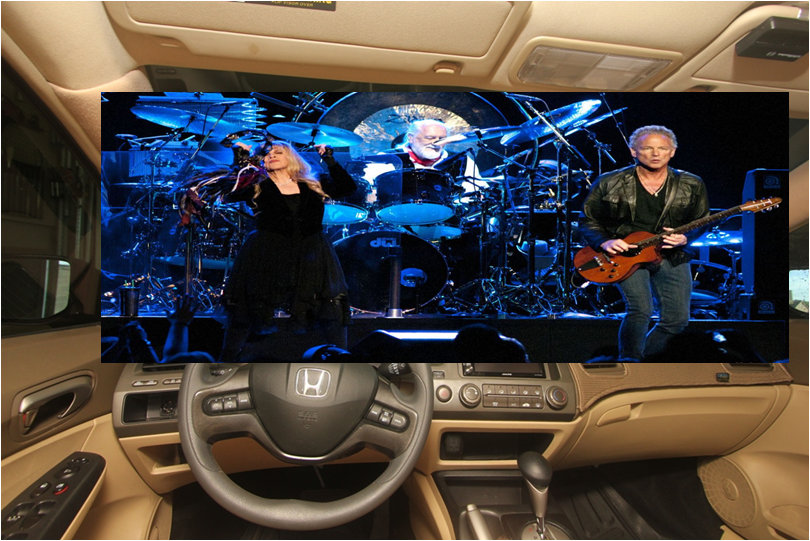Basic Audio Terms:
Knowing the basic definitions of soundstage can really help you understand why certain DSP aspects are needed and how they can be implemented. So, let’s look at one of the most basic and important aspects of soundstage:
- Balance: Center and Acoustic Boundaries
- To properly balance your system is it important to know your stage boundaries.
- In acoustics, these boundaries are defined as the left-most stage and the right-most stage.
- You know a center is the point in space between two lines. Therefore, the acoustic center should be placed mid-way between your acoustic boundaries. The center shouldn’t be an artificial point on your dash: it is the acoustic center of the acoustic left and right boundaries.
- It’s important to note that not all recordings have the same characteristics; some may have a vocalist to the right of center. Others may place a kick drum to the left side of the stage. Judging your center by a sole vocalist or instrument can be misleading if you don’t know for sure where that location on the stage really is supposed to be. So with that said, it’s a good idea to use correlated pink noise or a centered narrator (both provided in my Test CD) to determine center.
- Depth, Width, Height
- Each of these have importance as well, but I feel focusing on the center and putting that in the appropriate location with respect to your left and right boundaries will allow the other aspects to “fall in place”
Time Alignment and Levels:
Typically, in a car, the listener is positioned so that none of the speakers are the same distance from him.
The below illustrates a standard car setup with only a single speaker on each side creating not only a near-side biased stage, but also incoherency in the sound due to poor time arrival differences. There is a clear stage boundary, but no focus and no way to really pick out a center.

In the example above, the Left/Right speaker delta is 11 inches. In time, 11 inches is approximately 0.808 ms, which means that the left speaker’s sound arrives 0.808ms before the right speaker’s sound. This would create a left side bias due to ITD.
The SPL at your seat is approximately 2dB higher from the left side. This would also create a left side bias but due to IID.
The combination of ITD & IID would drive an overall stage that sounds squished to the left; there would be very little focus if any and no well-defined acoustic boundaries or center.
Given what we learned about our hearing based on ITD & IID, we can use our DSP’s time alignment and level features so that each speakers’ sound arrives to you at the same time as opposed to the nearside sound arriving first.
Of course, it should be noted that this really assumes properly acoustic polarity has already been accounted for. A simple 0/180 degree “phase” swap. In some cases wiring your speakers up in electrical polarity the correct way doesn’t necessarily mean you’ll get the correct acoustic polarity. Phase will be discussed more in the following section.
Time Alignment:
Time Alignment and Level Matching’s use is to give the impression that all sounds arrive to the listener at the same time based on ITD & IID. In short, if you want to simulate a sound arriving later from one speaker than another you add time delay and decrease the output which you want to push away.
Time Alignment can be derived in simple (tape measure) or complex (measurement system with loop-back) manners.
The simple method is:
- Use a tape measure to determine the distance of each driver from your listening position.
- Measure approximately from the speaker voice coil (if you can’t see it, add the appropriate amount to the cone) to the center of your ears.
- Use the following site to determine the approximate time delay needed to ensure each speakers’ sound arrives at the same time:
- http://tracerite.com/calc.html
The complex method would be one using measurement gear to measure the impulse response of your speaker. But, this will not be discussed due to time constraints. Maybe later, though.

Levels:
Given that levels are more dominant in regards to staging in higher frequencies, tweeters are typically the most impacted drivers when it comes to level setting between left and right. Additionally, in acoustics, each doubling of distance would result in the halving of SPL; in this case the left side’s output would *likely be stronger.
*Note: If the left speaker is aimed off axis, it would permit the higher frequency content to roll off a bit sooner thus helping to mitigate the IID bias to the left speaker. This is why some home speaker setups are aimed inward. Something to chew on....

There is no real easy way to adjust for levels via a calculation. I mean, there is… but real world things cause issues here:
- Did you set the gains the exact same?
- The environment will take a flat speaker response and make it not so flat.
- Are the speakers the exact same sensitivity?
- Bigger concern between driver types such as a midrange and tweeter, as opposed to two of the same midranges.
The best way to start off adjusting levels is to do so using pink noise and listening to high frequency content (>2khz) and adjusting levels until you achieve a good balance between left and right stage. Another option is to use an RTA or Phone app that will approximate the SPL at your seat from each speaker.
Using Time Alignment and Levels to create a Balanced Stage:
- The ITD aspect:
Using the simple T/A method, you determine that the left speaker delay should be set to 0.80 ms. - The IID aspect:
You also have determined via SPL measurement that you need to attenuate the left speaker 2dB to match with the right speaker.
What you wind up with a more equal representation of left and right stage boundaries, resulting in more width and a more realistic center location for your stage.
So, what you should now have is something *CLOSE* to this:

Another way to consider it is going from this ...

... to this ...

Recap:
Remember, when adjusting levels and time delay what you’re adjusting with one speaker is RELATIVE to the other speakers. You’re adjusting the nearest speaker(s) so that it sounds as if it has the same intensity and time of arrival as the furthest speaker. This would then sound as if the other speaker had moved.
Or think of it like this: you’re moving your ‘center’ with respect to the left and right boundaries. You continue to do this until your boundaries sound equidistant from the center vocalist/pink noise.




 Menu
Menu













 Recent Posts
Recent Posts
